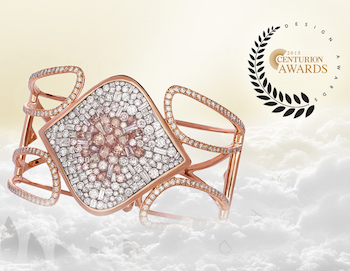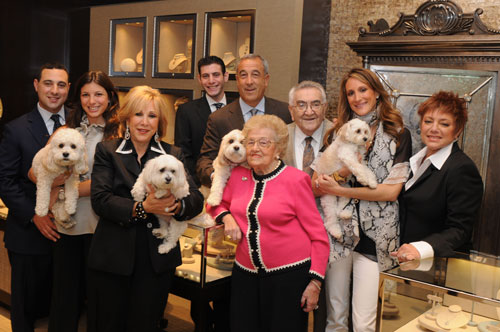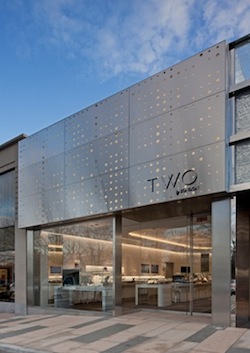Articles and News
London Jewelers’ Scott Saunders Discusses The Store’s Growth, Evolution, And Opening At Ground Zero | March 30, 2016 (0 comments)

New York, NY—Scott Saunders (left), senior vice president of business development for Manhasset, NY-based London Jewelers, was one of the Power Talk speakers at the recent WJA In The Know conference. The Q&A focused on the changing jewelry industry and how to succeed in the new marketplace. (Image: Newsday)
“I started in the industry when chain was being sold by the piece and herringbone was big innovation. There was no memo, you shook hands and paid in 30 days. I was selling all the mass merchants,” Saunders stated. But all that changed when gold went to $1400, he said, at which time he was recruited by Pluczenik, a major diamond sightholder. He helped develop Plevé, the diamond mosaic line designed by Ron Rizzo, then asked the Udells, owners of London Jewelers, if they wanted to buy into the brand. They said yes—and then hired Saunders themselves. His mission was to help the fourth-generation 90-year-old jeweler grow the business and transform its operations. (More about London Jewelers here.)

Plevé won a Centurion Design Award in 2015. More about the brand here.
“[The Udells] realized they could not sustain and grow London Jewelers as a mom-and-pop operation,” said Saunders. With 12 stores that weren’t all the same, they needed to bring in professionals like a CFO and a COO to grow the business, he explained. When he arrived, his first goal was to find synergies and economies of scale to leverage buying and marketing power. That, he said, was a little too luxury-based and too driven by brands.

The Udell family, both two- and four-legged, in 2014. Back row, left to right: Zachary, Mark, Mayer, Randi, and Allyn Udell. Front row, left to right: Scott, Jessica, Candy, and Fran Udell. Canine: Zoey, Chloe, Bailey, and Harley.
At the top of Saunders’ 2016 wish list is improving the firm’s digital market and social media strategy, and he says the entire industry needs to focus on training.
“We're an industry that doesn't train. You go to Macy's, you go into training program. You work on Wall Street, you go into a training program. But [in the jewelry industry] you go onto the floor.” The big buzz among retailers is the need to train better, clientele better, and convert better. Sales were up in 2015—but clients were down. “We have to convert better,” Saunders stressed.
Next he addressed digital and social marketing. What does it mean in practice?
“A lot of people think social is posting pictures and getting 500 likes. But it's about driving people to the website and then the store. We're not going to sell a lot online. We still think people want to come in person, try on, learn about designers, et cetera, and meet with our sales staff and learn about the story.”
Moderator Victoria Gomelsky asked how London Jewelers gives its customers a luxury experience.
Saunders replied with many popular strategies among luxury jewelers, such as giving customers lunch or coffee, taking jewelry off their wrist to clean and tighten, and rebuilding jewelry they’re not wearing in its present form. But the jeweler also creates unique, unusual experience events for clients, such as a painting class for 35 top women customers with designer Ippolita Rostagno, eponymous designer of Ippolita, one of the brands London carries.
“A lot of our clients are affluent, so we have to do these events to keep them engaged. We try and offer our clients interesting and unique experiences they may not get in other places," he said.
Gomelsky also asked about key marketing strategies and plans to open London’s first store in Manhattan, at the Westfield Oculus at the site of Ground Zero where the World Trade Center was attacked and destroyed on September 11, 2001.
In terms of marketing, Saunders says it's not just about Google ad words and top of the pecking order. He advises watching who are the influencers, who are attracting the collectors? For example, with watches, London posts lifestyle images, such as watches and Ferraris. “Everyone posts Instagram pictures of a wrist with jewelry but that's not exciting to consumers,” he said. “During the World Series we posted pictures of girls with Mets hats or shirts, and that got lot more ‘likes’ than regular pictures.
The new store, meanwhile, will be the only multi-branded store in the Westfield Oculus space. There will be a Two By London and also they will sell luxury brands like Rolex and they’re working on a project with Italian designer Roberto Coin.

Two by London's first location on Long Island; it will be part of London Jewelers' first Manhattan location in the new Westfield Oculus space where the former World Trade Center stood.
But it’s going to be quite different than the flagship store in Manhasset. For one thing, it’s a mall—with mall hours and people from all walks of life, says Saunders. Manhasset is strictly a luxury clientele, but here there will be everyone from entry level to executives of Goldman Sachs—potentially 300,000 people a day coming through the area—so from a product standpoint there needs to be a bit of something for everyone.
“We have to build a store that's a little bit of a different model and can appeal to a wider audience. We don't want to be Saks or Bergdorfs. We want to be London Jewelers with smattering of designers,” said Saunders. The store also is working with WJA to have a space for 90-day rotations of featured designers.
Lifestyles are getting more casual, says Saunders. People want things they can wear day and night. It’s less formal, and requires a unique approach and a unique spin.
“We’re very careful about not being redundant. If we have a brand, it’s because we’ve cultivated it and the consumer, and it’s the right brand for this kind of look.”







